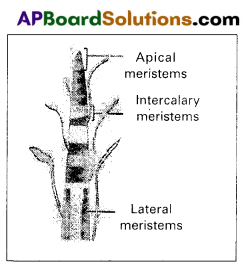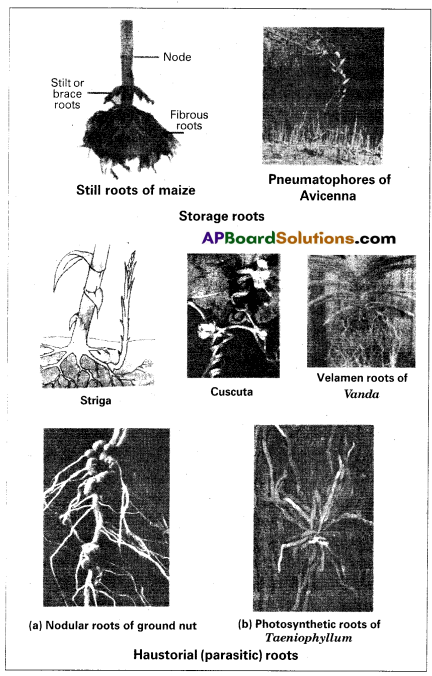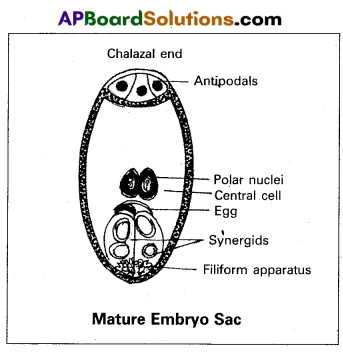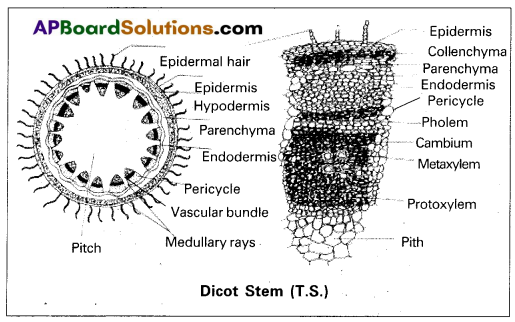Successful navigation through AP Inter 1st Year Botany Model Papers and AP Inter 1st Year Botany Question Paper March 2017 builds students’ confidence in their exam-taking abilities.
AP Inter 1st Year Botany Question Paper March 2017
Time: 3 Hours
Maximum Marks: 60
Section – A (10 × 2 = 20)
Answer All questions.
Question 1.
What is the basic unit of classification ? Define it.
Answer:
The basic unit of classification is species. A group of plants with similar characters is called species.
Question 2.
What does the terms phycobiont and mycobiont signify ?
Answer:
The algal component of lichen is called phycobiont. The fungal component of lichen is called mycobiont.
Question 3.
Name the books written by Parasara and mention the important aspects discussed in those books.
Answer:
Parasara wrote “Krishiparasaram” and “Vrikshayurvedam”. In Krishiparasaram”, he mentioned about agriculture and weeds. In Vrikshayurvedam”, he mentioned about 14 types of forests, external and internal characters of plants and medicinal plants.
![]()
Question 4.
What is meant by pulvinous leaf base ? In members of which angiospermic family do you find them ?
Answer:
The swollen leaf base is called pulvinous leaf base. It is seen in “Leguminosae” family.
Question 5.
What is meant by epipetalous condition ? Give an example.
Answer:
When the statements are attached to the petals, which is called epipetalous condition. Ex : Datura.
Question 6.
What is geocarpy ? Name the plant which exhibits this phenomenon.
Answer:
The development of fruit inside the soil is called Geocarpy. It is seen in Arachis hypogea.
Question 7.
What is referred to as satellite chromosomes ?
Answer:
A few chromosomes have non-staining secondary constriction at a constant location which gives the appearance of small fragment called satellite. The chromosome with satellite is called satellite chromosome.
Question 8.
Starch, cellulose, Glycogen, chitin are polysaccharides found among the following. Choose the one appropriate and write against each.
a) Cotton fibre
b) Exoskeleton of cockroach
c) Liver
d) Peeled potato
Answer:
a) Cotton fibre : Cellulose.
b) Exoskeleton of Cockroach : Chitin
c) Liver : Glycogen
d) Peeled potato : Starch
![]()
Question 9.
An another has 1200 pollen grains. How many pollen mother cells must have been there to produce them ?
Answer:
300 pollen mother cells.
Question 10.
Hydrophytes show reduced xylem. Why ?
Answer:
All submerged organs are capable of absorbing water. So hydrophytes show reduced xylem.
Section – B (6 × 4 = 20)
Answer any Six of the following.
Question 11.
Give a brief account of dinoflagellates.
Answer:
a) Dinoflagellates are mostly marine and photosynthetic. They appear yellow, green, brown, blue or red depending on the pigment in their cells.
b) The cell wall has stiff cellulose plates on the outer surface.
c) They have two flagella and produce spinning movements. So these protists are also called “Whirling whips”.
d) The nucleus has condensed chromosomes which are without histones, called mesokaryon.
e) Some dinoflagellates like Noctiluca show bioluminescence.
f) Red dinoflagellates like Gonyaulax undergo rapid multiplication and make the sea appear red (Red tides in Mediterranean sea).
g) Toxins produced by them may kill fishes.
Question 12.
Differentiate liverworts and mosses.
Answer:
| Liverworts | Mosses |
| a) The plant body is thalloid which is prostrate, dorsiVentral and closely appressed to the surface. | a) The adult stage Gameto phore consists of slender axis with spirally arranged leaves, which gets attached to sub-stratum by rhizoids. |
| b) Vegetative reproduction is by fragmentation or by Gemmae. | b) Vegetative reproduction is by Gemmae fragmen tation or by budding. |
| c) Male and female sex organs are produced on the at same or different thalli. | c) Male and female sex organs are produced the apex of the leafy shoots. |
| d) Paraphyses are absent. | d) Paraphyses are present. |
| e) Elaters are present in the capsule which helps in which spore dispersal. | e) Peristomial teeth are present in capsule spore dispersal. |
| f) Spores germinate to form free living gametophyte. | f) Spores germinate to form creeping green, Branched protonema. |
| g) Ex : Marchantia. | g) Ex : Funaria. |
Question 13.
List the changes observed in angiosperm flower subsequent to pollination and fertilization.
- Calyx, Corolla, Stamens, style and stigma wither away.
- Ovary develops into fruit.
- Ovules develop into seeds.
- The zygote develops into embryo.
- Primary endosperm nucleus develops into endosperm.
- The synergid and antipodals disintegrates.
- Funicle of the ovule develops into stalk of the seed.
- Integuments develop into seed coats.
- Micropyle changes into seed pore.
- Hilum changes into scar of the seed.
![]()
Question 14.
Describe the essential floral parts of plants belonging to Liliaceae.
Answer:
The essential floral parts of Liliaceae are Androecium and Gynoecium.
Androecium : Stamens are six, in two whorls of 3 each, free or Epiphyllous, anthers are dithecous, basifixed, introrse and dehisce longitudinally.
Gynoecium : Tricarpellaiy, syncarpous, trilocular and superior ovary with many ovules on axile placentation. Style is terminal and stigma is capitate.
Question 15.
Differentiate between Rough Endoplasmic Reticulum (RER) and smooth endoplasmic reticulum (SER).
Answer:
| Rough Endoplasmic Reticulum | Smooth Endoplasmic Reticulum |
| 1) ER studded with ribosomes is called Rough ER. | 1) ER without ribosomes is called Smooth ER. |
| 2) These are mainly composed of cisternae. | 2) These are mainly composed of tubules. |
| 3) They are associated with nuclear membrane. | 3) They are associated with plasma membrane. |
| 4) They mainly involved in Proteinsynthesis. | 4) They mainly involved in Lipid synthesis. |
Question 16.
Though redundantly described as a resting phase, interphase does not really involve rest. Comment.
Answer:
The interphase also called phase of non apparent division though called the resting phase. It is the time during which the cell is preparing for division by undergoing cell growth and DNA replication. The interphase is divided into three further phases. They are a.G1 phase, S-phase and G2 phase.
a) G1 phase : It corresponds to the interval between mitosis and initiation of DNA replication. In this, the cell is metabolically active and grows continuously.
b) S-phase: DNA replication takes place. The amount of DNA per cell doubles.
c) G2 phase : Proteinsynthesis continues. Cell organelles increases in number.
Question 17.
State the location and function of different types of meristems.
Answer:
a) Apical meristems : The meristems that are present at the tip of the stem and at the tip of the root are called apical meristems. They help in linear growth of the plant body.
b) Intercalary meristems: The meristems that are present in between mature tissues are known as intercalary meristems. They contribute to the formation of the primary plant body and also involves in internodal length.

c) Lateral meristems : The meristems that occur in the mature regions of roots and shoots peri – pherally called lateral meristems. They help in increase in thickness of the plant organs.
e.g : vascular cambium and Cork cambium.
![]()
Question 18.
Write a brief account of classification of xerophytes.
Answer:
Xerophytes are classified into three types.
They are :
a) Ephemerals: These are annuals which complete their life cycle within a short period. Ex : Tribulus.
b) Succulents: They absorb large quantities of water during rainy season and store it in different plant parts in the form of mucilage. As a result the plant parts become fleshy or succulent. The store water is used during dry periods. Ex: Stem succulents : Opuntia. Root succulents : Asparagus. Leaf succulents : Aloe.
c) Non succulents: These are perennial plants can withstand prolonged period of drought. Ex : Casuarina.
Section – C (2 × 8 = 16)
Answer any Six of the following.
Question 19.
Define root modification. Explain how root is modified to perform different functions.
Answer:
A change in the normal structure of root to carry out new functions according to environment is called root modification.
Root modifications: In some plants, roots change their shape ind structure to perform functions other than absorption and conduction of water and Minerals called root modifications.
They are of different types.
- In Carrot, turnip (Tap roots), Sweat potato (Adventitious roots), Asparagus (Fibrous roots) become swollen due to storage of food called storage roots.
- In Banyan tree, Roots arise from the branches grow into the soil, become pillar like and give additional support called prop roots or pillar roots.
- In Maize, sugarcane, roots arise from the lower nodes of the stem, give additional support called stilt roots.
- In Mangroves like Rhizophora and Avicennia, Many roots come out of the ground and grow vertically upwards, help in respiration called Pneumatophores.
- In Epiphytes like Vanda, special adventitious roots arise, help in absorption of moisture from almosphere called Velamen roots.
- In partial parasites like viscum and strga, some Haustorial roots enter into xylem of the host plant to get water and Minerals. In complete parasitic like cuscuta and Rafflesia, the haustorial roots enter into xylem and phloem of the host plant and obtain water and Minerals and food materials called Parasitic roots.
- In the members of Fabaceae, the roots are inhabited by Rhizobium bacteria which helps in N2 fixation called Nodular roots.
- In some plants like Taeniophyllum, the roots are chloro- phyllous and perform photosynthesis so called photosynthetic roots.


Question 20.
With a neat labelled diagram, describe the parts of a mature angiosperm embryo sac. Mention the role of synergids.
Answer:
Mature angiosperm embryosac shows three parts.
They are :
1) Egg apparatus
2) Antipodals
3) Central cell

1) Egg Apparatus: Three cells present towards the micropyle of the embryosac together called egg apparatus. Of which, the central, largest one is called egg and two lateral cells are called synergids. Synergids show finger like projections towards the micropyle called filliform apparatus.
2) Antipodals : Three cells present towards the chalazal end of the ovule are called antipodals. They are also referred to as vegetative cells of the embryosac and disintegrates before or after fertilisation.
3) Central cell : It is the largest cell of the embryosac. It is formed by the fusion of two polar nuclei. It is also called secondary nucleus. It shows central vacuole and 2 haploid polamuclei.
![]()
Question 21.
Describe the T.S. of a dicot stem.
Answer:
The structure of young dicot stem can be clearly understood by observing the transverse section of stem of Helianthus annus (sunflower). It shows three major zones, namely epidermis, cortex and stele.
1. Epidermis : It is the outer most layer of rectangular or tabular cells arranged compactly without any intercellular spaces. On outer surface of epidermis, a waxy layer called Cuticle is found. The cuticle is chemically composed of a substance cutin. The cell walls of epidermis also show the presence of cutin. Stomata are present in the epidermis. Multicellular trichomes develop on the epidermis. The cuticle and the trichomes check the evaporation of water and protect the stem from high temperature.
The epidermal layer gives protection to the inner tissues and also prevents the evaporation of water from the plant body. Through stomata, the epidermis allows the exchange of gases and promotes transpiration. Trichomes prevent entry of pathogens.
2. Cortex : The part extending between the epidermis and the stele is known as cortex. The cortex is smaller than the stele. It shows three sub-zones, namely
i) Hypodermis
ii) General Cortex and
iii) Endo- dermis.
i) Hypodermis : This is the outermost part of cortex and composed of 3-6 rows of collenchymatous cells. It is found beneath the epidermis and helps in providing tensile strength (elasticity) to the stem. The cells are arranged compactly without intercellular spaces and show excessively thickened corners. The cells are filled with active vacuolated cytoplasm possessing chloroplasts. Thus, the hypodermis also helps in the assimilation of food materials. It also gives mechanical strength.
ii) General Cortex : It is found beneath the hypodermal layer and is made up of 5 – 10 rows of thin walled, living parenchyma cells with or without intercellular spaces. These cells may be isodiametric or oval or spherical. The outer layers of cells contain chloroplasts and in the inner layers, leucoplasts are found. The general cortex is primarily concerned with the assimilation and storage of food materials.
iii) Endodermis : The inner most layer of cortex is called endodermis. The cells are barrel shaped, compactly arranged without intercellular spaces. The endodermis cells contain vacuolated protoplasts and show starch grains. So it is also known as Starch Sheath.
3) Stele : The central conducting cylinder is called the Stele’. It occupies a major part of the stem. It is composed of 4 parts.
i) Pericycle
ii) Vascular bundles
iii) Pith or Medulla and
iv) Medullary rays.
i) Pericycle : It is present in the form of a discontinuous ring and is made up of 3 – 5 rows of the thick walled, dead, lignified cells which gives mechanical strength to the stele. It appears as semilunar patches of sclerenchyma above the vascular bundles with intervening masses of parenchyma.
ii) Vascular bundles: About 15-20 vascular bundles are arranged in the form of a ring. This arrangement is called eustele. Each vascular bundle is wedge or top shaped. In the vascular bundles xvlem and phloem are arranged on the same radius. A meristematic layer of cells called cambium is present in between the xvlem and phloem. So they are called conjoint, collateral and open vascular bundles. Xylem is at the lower side and phloem at the upper side of the vascular bundle.
Xylem consists of vessels and xylem parenchyma. There may be few tracheids and xylem fibres. The metaxylem is towards the pericycle and protoxylem towards the pith. This is called endarch xylem. Phloem consists of sieve tubes companion cells and phloem parenchyma. Xylem and phloem are vascular tissues which conduct water, mineral salts and organic solutes respectively.
iii) Medulla : It is the central part of the stele and filled with thin walled parenchymatous cells, showing intercellular spaces. It is well – developed, extensive and occupies a large part of the stele. The chief function of the medulla is to store food materials.
iv) Medullary rays : The cells of the medulla extend to the periphery in between the vascular bundles. These cells are horizontal rows of thin walled, living and elongate radially, forming primary medullary rays.
The medullary rays connect the stele with the cortex and are helpful in lateral conduction.
